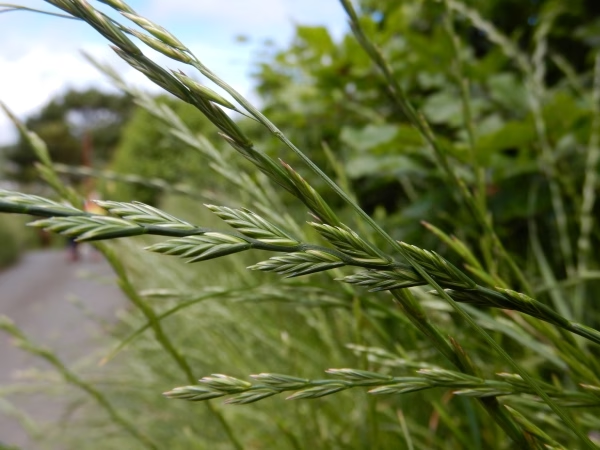
Perennial Ryegrass
Botanical Name
:
Lolium perenne
Plant Type
:
Cool-season perennial bunchgrass
Seasons
:
Grows actively in spring and fall, may struggle in hot summers
Sun Level
:
5–8 hours of full sun daily (tolerates partial shade but prefers full sun)
Ideal Soil Temperature for Planting
:
50–65°F (10–18°C)
Soil Type
:
Well-draining, fertile loam or clay loam
Hardiness Zones
:
3–7 (USDA)
Germination
:
Fast, typically within 5–10 days under optimal conditions
P.H. Level
:
5.5–7.5
Water/Irrigation
:
It requires consistent moisture, especially during establishment. Apply at least 1 inch of water per week during dry periods to maintain growth and color
Fertilization
:
Apply nitrogen-rich fertilizer in early spring and fall
Habit
:
Low-growing, tufted, hairless grass with a bunching (or tillering) growth habit
Final Plant Height
:
12–24 inches (in unmowed conditions)
Spread
:
As a bunch-type grass, it spreads through tillering rather than horizontal growth
Spacing
:
To ensure even coverage, sow lawns at 3 to 5 pounds per 1,000 square feet
Flowers
:
Produces small, inconspicuous flowers in spike-like seed heads (typically mowed before flowering in lawns)
Attracts
:
Not a major attractor for pollinators but can provide cover for small wildlife
Uses
:
Ideal for lawns, overseeding, erosion control, and pasture; valued for quick establishment and wear tolerance
Companions
:
Not necessary but can be combined with Kentucky bluegrass, fine fescues, and tall fescue (often mixed for turf applications)
Pruning
:
Begin mowing when the grass reaches about 3 inches tall, cutting it back to 2 inches (for home lawns). Avoid removing more than one-third of the leaf blade per mowing
Toxicity
:
Non-toxic to humans and pets but can cause issues if infected with endophytes (toxic to livestock)
Pests
:
Susceptible to billbugs, armyworms, cutworms, and sod webworms
Diseases
:
Prone to brown patch, gray leaf spot, rust, red thread, and Pythium blight
Fun Fact
:
Perennial ryegrass is favored on sports fields and golf courses due to its rapid germination and quick recovery from wear
Botanical Name
:
Lolium perenne
Plant Type
:
Cool-season perennial bunchgrass
Seasons
:
Grows actively in spring and fall, may struggle in hot summers
Sun Level
:
5–8 hours of full sun daily (tolerates partial shade but prefers full sun)
Ideal Soil Temperature for Planting
:
50–65°F (10–18°C)
Soil Type
:
Well-draining, fertile loam or clay loam
Hardiness Zones
:
3–7 (USDA)
Germination
:
Fast, typically within 5–10 days under optimal conditions
P.H. Level
:
5.5–7.5
Water/Irrigation
:
It requires consistent moisture, especially during establishment. Apply at least 1 inch of water per week during dry periods to maintain growth and color
Fertilization
:
Apply nitrogen-rich fertilizer in early spring and fall
Habit
:
Low-growing, tufted, hairless grass with a bunching (or tillering) growth habit
Final Plant Height
:
12–24 inches (in unmowed conditions)
Spread
:
As a bunch-type grass, it spreads through tillering rather than horizontal growth
Spacing
:
To ensure even coverage, sow lawns at 3 to 5 pounds per 1,000 square feet
Flowers
:
Produces small, inconspicuous flowers in spike-like seed heads (typically mowed before flowering in lawns)
Attracts
:
Not a major attractor for pollinators but can provide cover for small wildlife
Uses
:
Ideal for lawns, overseeding, erosion control, and pasture; valued for quick establishment and wear tolerance
Companions
:
Not necessary but can be combined with Kentucky bluegrass, fine fescues, and tall fescue (often mixed for turf applications)
Pruning
:
Begin mowing when the grass reaches about 3 inches tall, cutting it back to 2 inches (for home lawns). Avoid removing more than one-third of the leaf blade per mowing
Toxicity
:
Non-toxic to humans and pets but can cause issues if infected with endophytes (toxic to livestock)
Pests
:
Susceptible to billbugs, armyworms, cutworms, and sod webworms
Diseases
:
Prone to brown patch, gray leaf spot, rust, red thread, and Pythium blight
Fun Fact
:
Perennial ryegrass is favored on sports fields and golf courses due to its rapid germination and quick recovery from wear
Written by Salome Wapukha – https://www.linkedin.com/in/salome-wapukha-556700193/

